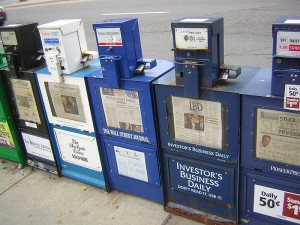
A news site online is a step back from journalism on display in a public space.
Recent work took me to a hotel on the edge of the Inner Harbor in downtown Baltimore. Those few square miles have everything a city might want: one of the two finest aquariums in the United States, scores of restaurants and shops, classic wooden ships moored in the small rectangular harbor, and a ring of convention hotels. Just a few blocks back sits the legendary Camden Yards baseball field, just an over-the-fence shot from Babe Ruth’s birthplace. And further up Platt St: a stunning cathedral-sized train shed full of fascinating remnants of the Civil War.
One morning I needed a news hit beyond the chatty hosts of the morning talk shows. And I was tired of reading headlines from my tablet, with its cramped size and its jumpy touch-screen.
What I didn’t expect was that it would be a major challenge to buy that simple artifact of the civil society, a real newspaper.
Of course it’s old news that hard copies from nation’s biggest journalistic institutions are on the way out. The thought of a newspaper subscription never comes up among my students, though some find their way to these outlets online. According to the Pew Research Center, only a quarter of millennials show any interest in political or civic news; a fact that doesn’t bode well for the future.
If we think an occasional glance at Gawker or CNN or Fox News will keep us in the loop, we’re badly mistaken.
Even so, one would expect to pass street kiosks and stores still hawking hard copies of papers from the many cities in the nation’s populated northeast corridor. After all, half of all news subscribers in the nation still read paper-only versions. Yet on that day this vital instrument of the open society was mostly absent from the public square.
The clerk in the store on the first floor of my posh hotel didn’t flinch when she said they carried no papers. None? So I started a slog across the harbor plaza, passing the tall ships, the overpriced chain restaurants selling all things fried, and perhaps another fifty establishments waiting for buyers of what most of us don’t really need (i.e., a candy store the size of a supermarket). Surely there would be a corner box selling The Baltimore Sun or USA Today, or The New York Times or perhaps the Washington Post. No luck. Then into a Barnes and Noble in its stunning Power House venue next to the National Aquarium. Yet again I seemed to be striking out. Then a staffer told me to ask someone behind the check-out counter. And, sure enough, from under a desk in a corner of the store came a copy of The Post. Why it was hidden from public view I will never know. I felt like a citizen of Soviet times picking up some illicit samizdat from a dissident. Even pornography seemed to have better placement in the store.
This is all dismaying. Access to a news site online is not the same as news displayed in the places we frequent. The front pages especially of the nation’s tabloids were always written to draw in the passerby. Their “screamer” headlines were meant to turn recent events into news you somehow needed. Anybody walking down a street in the 1970s or 80s got a register of the nation’s pulse even if they weren’t buying.
Seeking out these sites online against mountains of competitors is a step towards the isolation of national and local news, with the consequence of equal isolation of the civil sphere from the rest of American life. These agents of democracy obviously hang by a frayed thread, competing in a carnival of more provocative digital content. It’s no surprise digital news platforms are in financial trouble, and that newsrooms once built for sizable staffs are now some of the lonelier offices on the planet.
The deeper problem is that there are too few newspapers sitting in the driveways or front steps of homes in our neighborhoods. If we think an occasional glance at Gawker or CNN or Fox News will keep us in the loop, we’re badly mistaken. And at about 200 words a minute, television news reduces events to headlines rather than discursive coverage. The ubiquitous newspaper available on a city’s streets remains the much richer form of reporting, and an important marker of our connections to this culture we call our own.
Comments: woodward@tcnj.edu
